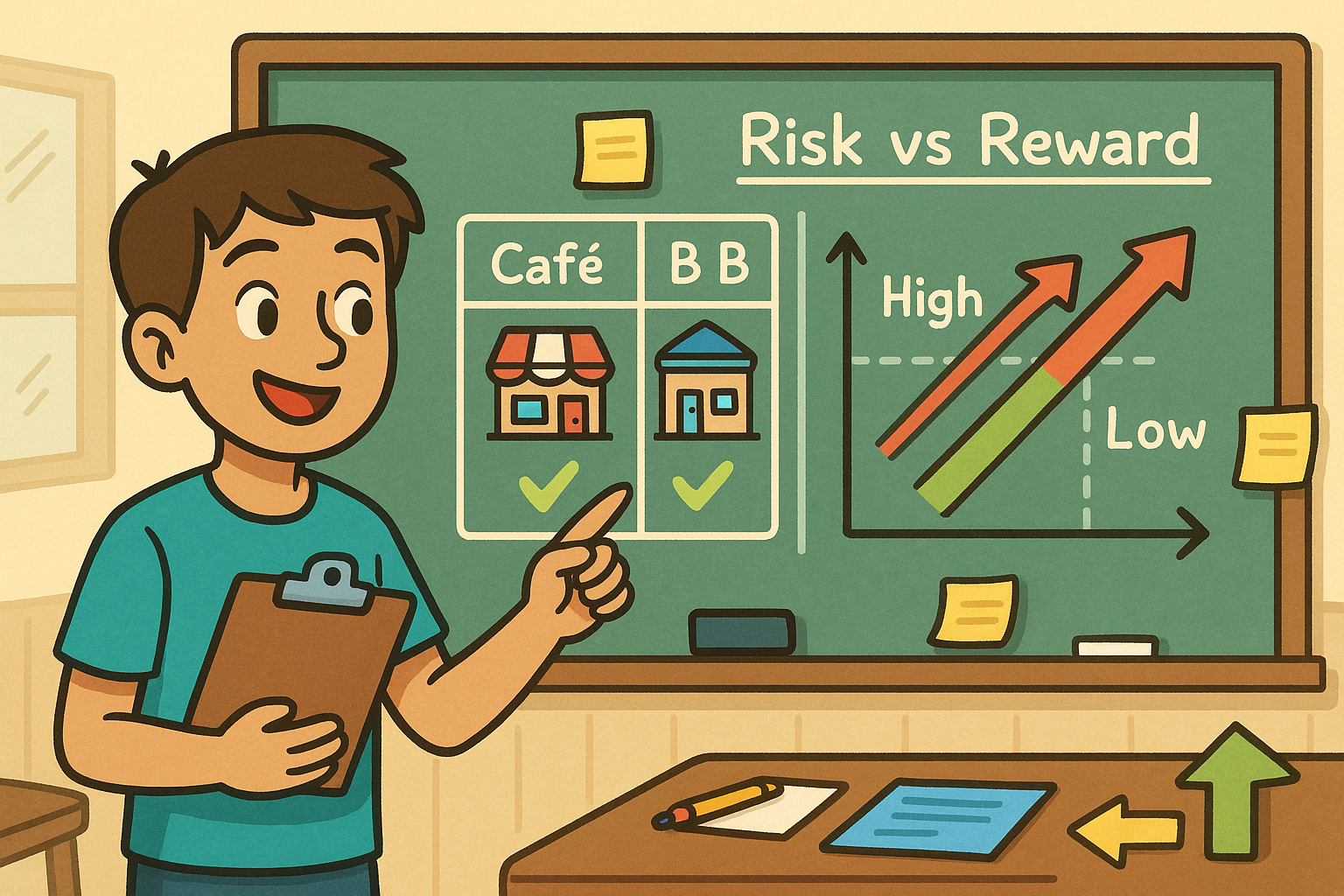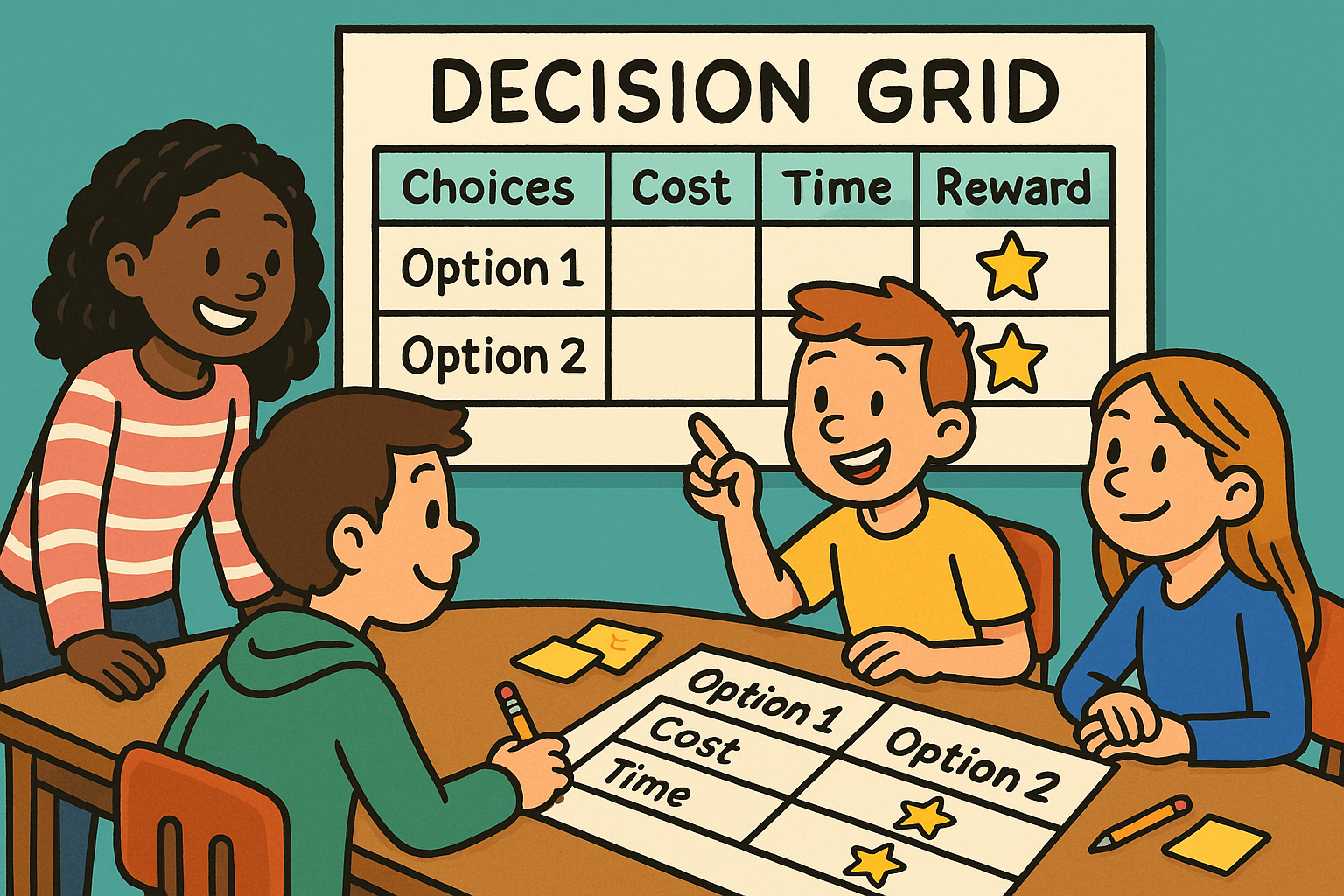🧠 Decision-Making in Business
Every day, you make hundreds of decisions — what to eat, where to go, who to text.
Most take seconds. But in business, a single decision can change everything.
That’s why great entrepreneurs don’t rush — they pause, analyze, and choose with intention.
🎯 Why Decisions Matter
In business, every action costs time, money, or reputation.
A poor choice can waste all three.
Learning to make decisions like a professional gives you power — not just to react, but to lead.
💬 Good decision-making = clarity + timing + courage
Even when there’s uncertainty, you can still make a good decision — not by guessing, but by reasoning.
⚖️ The Decision Triangle
Think of every business decision as a triangle with three sides:
- Information — What do I know for sure?
- Options — What can I choose between?
- Risk — What could go wrong, and can I live with it?
When one side is weak, the triangle collapses.
🧩 Example: Two Coffee Shops
You have $10,000 to invest. Two options appear:
| Factor | Café A | Café B |
|---|---|---|
| Location | Next to a busy school | In a quiet neighborhood |
| Startup cost | $10,000 | $6,000 |
| Expected profit (monthly) | $2,000 | $1,200 |
| Owner experience | New | 3 years |
| Risk | High | Low |
Which would you choose?
There’s no single “correct” answer — but good decision-makers think like this:
“If I’m okay with higher risk for more reward, Café A fits.
If I prefer stability, Café B wins.
Either way, I understand why.”

Comparing options — visualizing risk versus reward helps make smarter, more confident business decisions.
🧩 The 3-Step Decision Framework
You don’t need spreadsheets to think like a CEO.
Try this framework whenever you face a real or study decision:
1. Define the Goal
Ask yourself:
- What am I trying to achieve?
- What will success look like in 1 week or 1 month?
🧭 Example: “I want to attract more customers to my school event.”
2. Compare Options Logically
Make a quick table — pros, cons, and data if available.
| Option | Pros | Cons |
|---|---|---|
| Posters around school | Easy, free | Low reach |
| Instagram ads | Wider reach | Costs $15 |
| Invite a popular student to promote | Personal connection | Hard to organize |
Now choose the one that matches your goal and fits your limits.
3. Act, Measure, Learn
Even the best decisions can go wrong — what matters is how you learn from them.
After acting:
- Check what worked.
- Adjust your plan.
- Note what you’d do differently next time.
That’s how businesses evolve: test → learn → adapt.
🧮 The Cost of Waiting
Sometimes the hardest part is deciding when to decide.
If you wait too long, opportunities vanish.
If you decide too fast, you risk mistakes.
That’s why good decision-makers balance speed and accuracy.
📏 “Move fast when the cost of being wrong is small.
Move carefully when it’s huge.”
This simple mindset separates impulsive decisions from smart ones.

Using a decision grid helps visualize trade-offs between cost, time, and reward — a simple tool for smart decision-making.
💬 Case Practice: The Laptop Dilemma
Imagine you need a new laptop for design projects.
Option A costs $800 with great reviews.
Option B costs $500 but slower.
You have $1,000 in savings.
Ask yourself:
- What’s the purpose — gaming or schoolwork?
- How long do I plan to use it?
- If I wait for a sale, what’s the risk of delay?
Now make your decision — and explain it in writing.
That reflection builds your decision muscles.
🌍 Real-World Patterns
Famous entrepreneurs follow these principles every day:
- Jeff Bezos (Amazon): “Most decisions are reversible — make them fast.”
- Sara Blakely (Spanx): “You learn faster from action than from fear.”
- Elon Musk: uses first principles — breaking problems into basics before deciding.
You don’t have to be them — but you can borrow their thinking habits.
🧩 Practice Activity
Create your own “Decision Journal” for one week.
Each time you make a choice, note:
- The decision
- Your goal
- The information you had
- The outcome
In a few days, you’ll see your personal patterns — emotional, logical, or balanced.
This awareness is step one to business acumen.
💡 Why This Matters
Learning to decide well affects everything:
- Choosing the right projects or teammates.
- Spending your time wisely.
- Managing risk before it manages you.
Good decisions build trust, progress, and momentum — the foundation of leadership.
💬 Remember:
The goal isn’t to be perfect — it’s to think clearly, act confidently, and learn continuously.
In the next lesson, we’ll explore how to use these skills to solve problems creatively and critically — even when the answer isn’t obvious.
📝 Try this today
Write down 3 small decisions you made this week. For each one, ask: What was my goal? What options did I consider? What did I base my choice on?
Pick a daily decision (like buying something or joining an activity) and make a pros/cons table before acting.
Read the story of two coffee shops below and decide which one you’d invest in — explain your reasoning.
Lesson Progress
Module: acumen · +0% upon completion